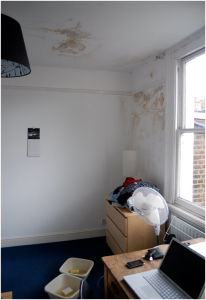When you’re looking for a house, the first two things to check are the foundations and the roof. Why? – because they are the most expensive to fix. Of the two, the roof is most likely to give you problems.

Roof problems can develop at any time. A gust of wind, traffic vibration or flexing roof ties can loosen flashing or lift a tile. Even sunlight can make roofing materials porous. The average roof is a devil to access and fix – almost all work has to be done from the outside.
You can extend a roof’s lifespan, and avoid or fix minor leaks by applying good quality sealants.
Problems with flat roofs
Because flat roofs have poorer drainage, fresh coats of roof sealant should be applied regularly. Although flat roofs are easier to access and work on, few owners look after them, which is a tragedy.
Insurers do not like them. When you get quotes for home insurance, brokers are supposed to ask how much of your roof is flat. Some insurers pull out if you have one. For advice about insuring them, see https://www.theaa.com/home-insurance/advice/flat-roof-insurance.
If you are not aware of a flat roof exclusion or you fail to declare it, there could be problems when you try to claim. Policies also require you to maintain them.

An insurer will not expect you to apply sealants to your main pitched roof, although you can avoid problems if you do.
How to seal your roof
If you are going to the trouble of applying roof sealant, make sure it is good quality. Many sealants and mastics on the market are based on silicone or polyurethane. Neither are very weather-resistant and polyurethane can emit toxic fumes into your home.
CT1 have the ultimate roof sealant. It contains minimal solvents, adheres well to all surfaces and can accommodate the movement caused by settlement or windy weather.
Providing you have safe access, applying it is straightforward. Clear loose material with a long brush, and then wash the roof with a roof cleaning fluid (such as TSP). You can add a bit of bleach too. Wear eye protection while you apply it, and then rinse and let it dry.
CT1’s product does not need a primer, but other products might. If you apply more than one coat – brush in a different direction each time.
